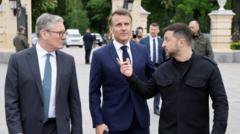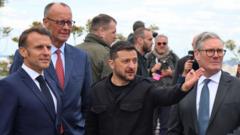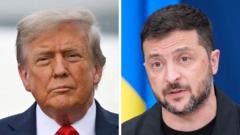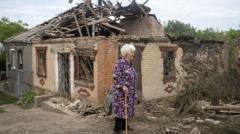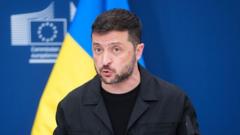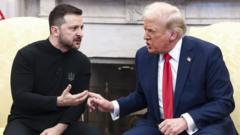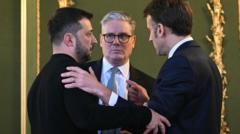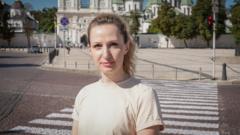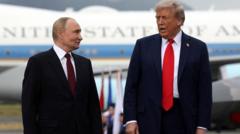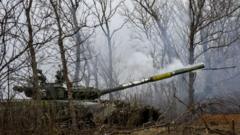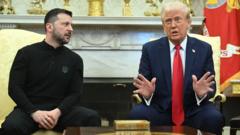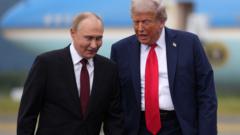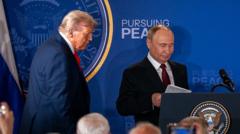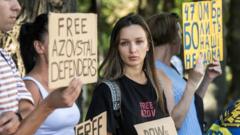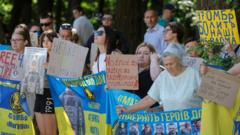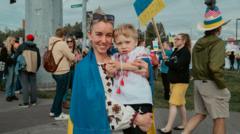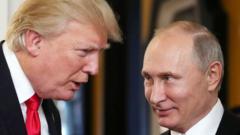**The annual Victory Day parade draws international leaders as Ukraine continues to face military aggressions, amplifying tensions surrounding the fragile ceasefire.**
**Putin's Victory Day Celebrations Amid Tensions and Ceasefire Controversy**
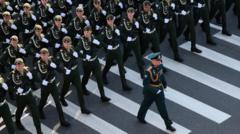
**Putin's Victory Day Celebrations Amid Tensions and Ceasefire Controversy**
**The Russian leader commemorates WWII victory under heavy security while Ukraine denounces a temporary ceasefire as a "theatrical show."**
In a display of national pride, Russian President Vladimir Putin led the Victory Day parade in Moscow's Red Square, marking the 80th anniversary of the Soviet Union's triumph over Nazi Germany. The event was significantly heightened by increased security measures following a series of Ukrainian missile strikes that targeted the capital in recent days.
A unilateral three-day ceasefire, announced by Russia to coincide with the festivities, has seen contentious reactions from Ukraine. Leaders including China's Xi Jinping have made the trip to Moscow, with Russia reporting attendance from over 20 foreign dignitaries. Ukraine, however, dismissed the ceasefire as merely a façade to protect the celebratory atmosphere of the parade, calling it a "theatrical show."
Military assessments suggest that Ukraine has endured thousands of attacks during the ceasefire period, as the Russian side maintains that they are observing the truce despite accusations of violations. The increase in hostilities leading up to the ceasefire included a barrage of missile exchanges between the two nations, along with significant air travel disruptions across Russia due to the ongoing conflict.
With 27 world leaders attending, the military parade featured thousands of Russian troops and showcased an array of weaponry. Ukrainian President Volodymyr Zelensky remains skeptical about the truce, stating that he cannot assure the safety of leaders attending the parade and urging them not to travel to Moscow.
Military analyst Mykhailo Samus shared thoughts with BBC, suggesting that Ukraine may forgo targeting the event due to the significant presence of international officials, while asserting that such a gathering could represent a legitimate military target.
In his recent address, Zelensky called for immediate and genuine ceasefire terms, emphasizing the need for an end to missile strikes and hostilities. He reiterated Ukraine's willingness to abide by a ceasefire, contrasting it with statements from Moscow, which cited thousands of breaches since the ceasefire took effect on May 8.
On the second day of the truce, reports detailed nearly 200 frontline clashes, with multiple airstrikes and instances of shelling by Russian forces. While Russian defense officials claimed that their troops had ceased combat operations along previously occupied territories, they noted a "mirror-like" response to Ukrainian assaults.
Zelensky has pushed for a prolonged ceasefire lasting at least 30 days, a stance echoed by Ukraine's allies in Europe and the U.S. Compounding the situation, Donald Trump called for an unconditional ceasefire, warning of potential sanctions against non-compliant parties.
The unfolding events exemplify the ongoing complexities and fragile nature of ceasefires in the Russia-Ukraine conflict, as military and diplomatic dialogues continue to clash amid the backdrop of ceremonial military displays.
A unilateral three-day ceasefire, announced by Russia to coincide with the festivities, has seen contentious reactions from Ukraine. Leaders including China's Xi Jinping have made the trip to Moscow, with Russia reporting attendance from over 20 foreign dignitaries. Ukraine, however, dismissed the ceasefire as merely a façade to protect the celebratory atmosphere of the parade, calling it a "theatrical show."
Military assessments suggest that Ukraine has endured thousands of attacks during the ceasefire period, as the Russian side maintains that they are observing the truce despite accusations of violations. The increase in hostilities leading up to the ceasefire included a barrage of missile exchanges between the two nations, along with significant air travel disruptions across Russia due to the ongoing conflict.
With 27 world leaders attending, the military parade featured thousands of Russian troops and showcased an array of weaponry. Ukrainian President Volodymyr Zelensky remains skeptical about the truce, stating that he cannot assure the safety of leaders attending the parade and urging them not to travel to Moscow.
Military analyst Mykhailo Samus shared thoughts with BBC, suggesting that Ukraine may forgo targeting the event due to the significant presence of international officials, while asserting that such a gathering could represent a legitimate military target.
In his recent address, Zelensky called for immediate and genuine ceasefire terms, emphasizing the need for an end to missile strikes and hostilities. He reiterated Ukraine's willingness to abide by a ceasefire, contrasting it with statements from Moscow, which cited thousands of breaches since the ceasefire took effect on May 8.
On the second day of the truce, reports detailed nearly 200 frontline clashes, with multiple airstrikes and instances of shelling by Russian forces. While Russian defense officials claimed that their troops had ceased combat operations along previously occupied territories, they noted a "mirror-like" response to Ukrainian assaults.
Zelensky has pushed for a prolonged ceasefire lasting at least 30 days, a stance echoed by Ukraine's allies in Europe and the U.S. Compounding the situation, Donald Trump called for an unconditional ceasefire, warning of potential sanctions against non-compliant parties.
The unfolding events exemplify the ongoing complexities and fragile nature of ceasefires in the Russia-Ukraine conflict, as military and diplomatic dialogues continue to clash amid the backdrop of ceremonial military displays.

